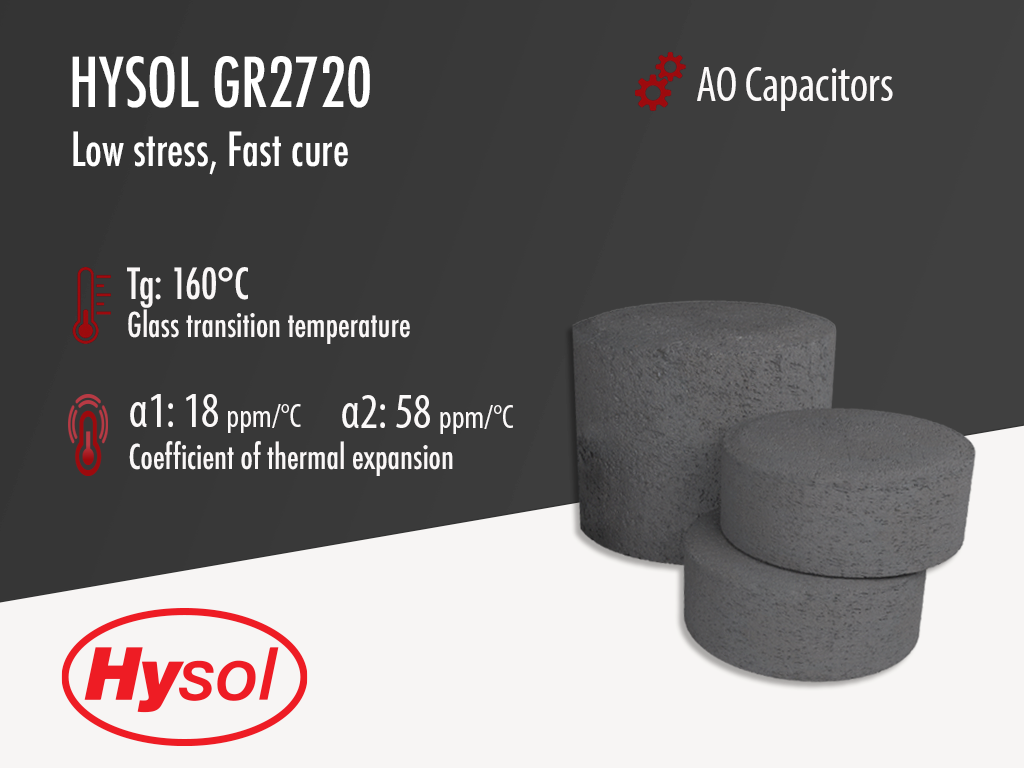Hysol GR2720 | Black Epoxy Mold Compound
- For conductive polymer and AO capacitors
- Excellent thin wall crack resistance
- Fast cure for automold equipment
Product Description
Hysol GR2720 is a low stress, black semiconductor-grade epoxy molding compound designed for the encapsulation and protection of Conductive Polymer Capacitors and Aluminum Organic (AO) capacitors. Polymer conductive capacitors and Aluminum Organic capacitors offer very high capacitance in a very small size. Epoxy molding compounds designed for these packages must have very low stress and very good thin wall crack resistance. This is the only way to be able to pass the MSL performance on these package types. GR2720 excels in both fields and has both low stress and excellent thin wall crack resistance.
Hysol GR2720 is a laser markable, environmentally free, halogen free "green" product, meaning that it doesn't contain any halogens including bromine, antimony or phosphorus flame retardants. This material is designed to achieve JEDEC Level 1 requirements at 260°C reflow temperature on Aluminum Organic (AO) capacitors as well as conductive polymer capacitors. Its fast cure time also ensures that it is compatible with the latest automold manufacturing equipment. Hysol GR2720 meets UL 94 V-0 Flammability at 1/4 inch (6.35mm) thickness.
Technical Specifications
| General Properties | |||||||||||
| Color Color The color | Black | ||||||||||
| Filler Content | 79 % | ||||||||||
| Specific Gravity Specific Gravity Specific gravity (SG) is the ratio of the density of a substance to the density of a reference substance; equivalently, it is the ratio of the mass of a substance to the mass of a reference substance for the same given volume. For liquids, the reference substance is almost always water (1), while for gases, it is air (1.18) at room temperature. Specific gravity is unitless. | 1.87 | ||||||||||
| |||||||||||
| Physical Properties | |||||||||||
| Spiral Flow @ 175°C | 96.5 cm | ||||||||||
| Chemical Properties | |||||||||||
| |||||||||||
| Moisture absorption | 0.30 % | ||||||||||
| Electrical Properties | |||||||||||
| |||||||||||
| Volume Resistivity Volume Resistivity Volume resistivity, also called volume resistance, bulk resistance or bulk resistivity is a thickness dependent measurement of the resistivity of a material perpendicular to the plane of the surface. | 3.2x1017 Ohms⋅cm | ||||||||||
| Mechanical Properties | |||||||||||
| |||||||||||
| |||||||||||
| |||||||||||
| Molded Shrinkage | 0.23 % | ||||||||||
| |||||||||||
| Thermal Properties | |||||||||||
| |||||||||||
| |||||||||||
| Glass Transition Temperature (Tg) Glass Transition Temperature (Tg) The glass transition temperature for organic adhesives is a temperature region where the polymers change from glassy and brittle to soft and rubbery. Increasing the temperature further continues the softening process as the viscosity drops too. Temperatures between the glass transition temperature and below the decomposition point of the adhesive are the best region for bonding. The glass-transition temperature Tg of a material characterizes the range of temperatures over which this glass transition occurs. | 160 °C | ||||||||||
| Thermal Conductivity Thermal Conductivity Thermal conductivity describes the ability of a material to conduct heat. It is required by power packages in order to dissipate heat and maintain stable electrical performance. Thermal conductivity units are [W/(m K)] in the SI system and [Btu/(hr ft °F)] in the Imperial system. | 0.7 W/m.K | ||||||||||
| UL 94 Rating UL 94 Rating Flammability rating classification. It determines how fast a material burns or extinguishes once it is ignited. HB: slow burning on a horizontal specimen; burning rate less than 76 mm/min for thickness less than 3 mm or burning stops before 100 mm V-2: burning stops within 30 seconds on a vertical specimen; drips of flaming particles are allowed. V-1: burning stops within 30 seconds on a vertical specimen; drips of particles allowed as long as they are not inflamed. V-0: burning stops within 10 seconds on a vertical specimen; drips of particles allowed as long as they are not inflamed. 5VB: burning stops within 60 seconds on a vertical specimen; no drips allowed; plaque specimens may develop a hole. 5VA: burning stops within 60 seconds on a vertical specimen; no drips allowed; plaque specimens may not develop a hole | V0 | ||||||||||
| Curing Conditions | |||||||||||
| |||||||||||
| |||||||||||
| Transfer Pressure | 40 - 85 kg/cm2 | ||||||||||
| Transfer Time | 6 - 15 s | ||||||||||






